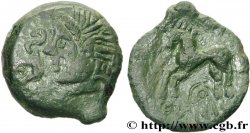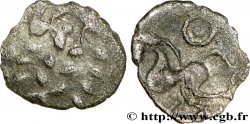v19_0455 - GALLIA - AULERCI EBUROVICES (Area of Évreux) Denier scyphate au cheval et au sanglier
MONNAIES 19 (2004)
Starting price : 200.00 €
Estimate : 500.00 €
Realised price : 200.00 €
Number of bids : 1
Maximum bid : 260.00 €
Starting price : 200.00 €
Estimate : 500.00 €
Realised price : 200.00 €
Number of bids : 1
Maximum bid : 260.00 €
Type : Denier scyphate au cheval et au sanglier
Date: c. 50-40 AC.
Mint name / Town : Évreux (27)
Metal : silver
Diameter : 13,5 mm
Orientation dies : 7 h.
Weight : 0,68 g.
Rarity : R3
Coments on the condition:
Très bel exemplaire pour ce type de petite monnaie en argent, souvent mal conservé. Frappe vigoureuse au revers, avec des débuts de cassures de coin sur le revers
Predigree :
Cet exemplaire provient du stock Argenor
Obverse
Obverse legend : ANÉPIGRAPHE.
Obverse description : Restes de tête humaine, surmontées par une couronne de laurier sur laquelle est posé un petit sanglier à gauche.
Reverse
Reverse legend : ANÉPIGRAPHE.
Reverse description : Cheval galopant à gauche ; au-dessous, un petit sanglier tourné à gauche ; un annelet au-dessus et devant le cheval.
Commentary
Cet exemplaire semble être le second connu après celui proposé dans MONNAIES XVIII, n° 865, ils sont tous deux de même coin de revers, mais celui-ci est d'une frappe antérieure, avec des cassures de coin moins prononcées. Cet exemplaire présente un annelet bien net devant le cheval. Au-dessus du cheval, on distingue trois annelets partant de la hampe, alors qu'un seul était visible sur celui de MONNAIES XVIII.
This example appears to be the second known after the one proposed in MONNAIES XVIII, No. 865. They both have the same reverse die, but this one is from an earlier strike, with less pronounced die breaks. This example has a very clear annulet in front of the horse. Above the horse, three annulets extending from the shaft can be seen, whereas only one was visible on the one in MONNAIES XVIII.
This example appears to be the second known after the one proposed in MONNAIES XVIII, No. 865. They both have the same reverse die, but this one is from an earlier strike, with less pronounced die breaks. This example has a very clear annulet in front of the horse. Above the horse, three annulets extending from the shaft can be seen, whereas only one was visible on the one in MONNAIES XVIII.








 Report a mistake
Report a mistake Print the page
Print the page Share my selection
Share my selection Ask a question
Ask a question Consign / sell
Consign / sell
 Full data
Full data










